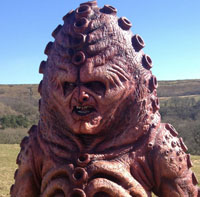 The fourth race on my list of the seven key humanoid ‘monster’ races are the shape-shifting Zygons.
The fourth race on my list of the seven key humanoid ‘monster’ races are the shape-shifting Zygons.Appearances
The Zygons have a slightly unusual history, compared with those I’ve dealt with so far. They first appear slightly later, during the fourth Doctor story Terror of the Zygons, but that’s not the oddity. They immediately stood out due to a distinctive design and a particularly well-respected debut story and after that they… well, they just didn’t appear again in the classic series. In fact, they didn’t appear on TV again for another 38 years, although they have now shown up as significant antagonists twice in the modern era.





